#amnesty class
Text
Not to get all fanon-y, but you know what?
La’an was rescued from the Gorn by the U.S.S. King Junior.
What if the King Jr. was a 2260s era Amnesty Class starship, or at least the prototype for the Amnesty Class? Literally the entire naming scheme has deliberately been historically significant liberators of oppressed minority groups.
Unless we get told otherwise that’s what I’m headcanoning now so 😎😜
#star trek#star trek ocs#star trek headcanons#the uss tubman#the uss king jr#amnesty class#Gorn#una chin riley#la’an noonien singh#fanon#Star Trek fanon#oc universe#snw#star trek strange new worlds
18 notes
·
View notes
Text
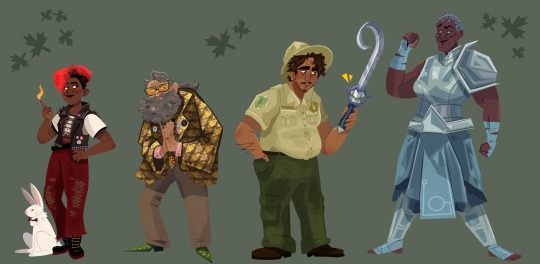
Kablamnesty for a class assignment
#I still don’t know how I managed to get taz fanart for a class assignment#I need Ned’s jacket tho now#the adventure zone#the zone cast#taz#taz amnesty#my art
328 notes
·
View notes
Text
About to start playing my first ttrpg in 3 years. New game, new party, new campaign. Ive never been so excited.
We’re playing monster of the week! we had session 0 last Saturday and I’m already in love with all our characters
Edit: idk why this posted so late
#I’m playing a slightly feral 12 yr boy#my class is the searcher#its my first time playing anything other than dnd 5e#i love TAZ amnesty so im excited to try this system#monster of the week#evil hat productions#the searcher#motw ttrpg#motw character#Kota the searcher#Kotarou Knote-Ogawa
15 notes
·
View notes
Text
Meet Ugly: we sit next to each other in class and I just spilled my coffee all over your expensive laptop.
Characters: Aubrey Little / Dani
Word Count: ~1k
Aubrey’s pretty sure the cute blonde girl who she sits next to in her philosophy lecture doesn’t know she exists.
Well, she knows she exists—they exchange polite smiles every day when Aubrey shows up to class and once she even asked Aubrey to borrow a pencil—but once they exit the classroom, Aubrey’s certain she fades out of the blonde girl’s mind like water out of her hands. Out of sight, out of mind sort of deal.
Aubrey doesn’t have that privilege. Perhaps it’s the fact that she’s had trouble making friends since beginning college, but this happens almost every semester: Aubrey develops a class crush that consumes every moment she’s in class (and many of the moments she’s not), and then after the semester ends Aubrey forgets all about them and the cycle begins anew.
And this time, she always finds her mind wandering back to the Pretty Girl Who Sits Next to Her in Philosophy.
Her name is Daniella Stevens—Aubrey’s watched her write her name on the attendance sheet in loopy handwriting enough times to know.
She’s got long, blonde hair that she usually wears down, sometimes paired with a bandana or ribbon. She has long eyelashes and a spotting of freckles on her nose. She carries a tote bag instead of a backpack. She never drinks coffee, only mango-flavored Monster energy drinks. She’s left-handed, and on the rare occasion that she takes notes on paper instead of her laptop, sometimes her arm bumps into Aubrey’s.
When class gets especially dull, Aubrey likes to guess things about what she’s like outside of class. In her mind, Daniella’s favorite band is The Cure and her favorite food is French Onion Soup. She likes horror movies and hates romance novels, and she spends her weekends shopping at Trader Joe’s and learning how to embroider.
Is it a bit psychotic? Maybe. But it keeps Aubrey awake during these philosophy lectures that drag on, and on, and on…
Aubrey takes a sip of her coffee (a cold brew with two pumps vanilla and sweet cold foam) and sighs. This particular lecture seems to have been going on for ages, the professor droning about Plato or Socrates or somebody, Aubrey can never keep track.
Daniella sits to her right, as she always does, taking dutiful notes on her laptop. Today she’s wearing a red knitted sweater and her hair is secured by a matching ribbon in a half-up, half-down style. Aubrey tries not to be obvious as she watches Daniella typing with quick fingers. Maybe she can ask her for her notes after class, since Aubrey hasn’t been paying a lick of attention.
She glances up at the clock; the professor should be ending class any second now. She taps her foot anxiously on the concrete floor of the lecture hall—wait, did she take her meds today?—and reaches for another sip of coffee.
The next few moments happen in such quick succession that Aubrey barely has time to process them: as the professor announces the end of class, Daniella moves her left arm to gather her things and bumps into Aubrey as she’s grabbing her coffee cup. Aubrey loses her grip on it, causing cold brew to spill all over both of their desks, Daniella’s laptop getting the brunt of it.
“Oh, shit!” Daniella says under her breath, watching helplessly as the screen of her laptop flickers for a moment and then turns off, unresponsive. “Shit, shit, shit…”
“Oh my god, I’m so sorry.” Aubrey feels her face flush with embarrassment as she reaches over and picks up her now empty coffee cup. “Holy shit, I’m so, so sorry!” Aubrey digs in her backpack for some napkins or tissues or something to help wipe up the mess. She comes up empty, and in her panic she begins mopping it up with the sleeve of her jacket.
Daniella fumbles with a button on the side, her hands trembling. The screen flickers to life for just a second, but then dies again. “No, no, no…” she’s saying.
“Fuck, is it broken?” Aubrey asks, dreading the answer. She starts calculating in her brain how much financial trouble she’s going to be in after she pays for a replacement.
“Yeah, I think so,” Daniella says, and Aubrey can see her blinking back tears. “Dammit.”
Aubrey would rather Daniella scream and curse her out in front of the entire lecture hall than sit here and watch her cry, knowing she’s the reason why.
“God, I’m so fucking sorry,” Aubrey says again, not sure what else there is to say. “I’ll buy you a new one, obviously. Just… holy shit, I’m so sorry.”
“No, it… I bumped you. It’s my fault.” It’s a lie to make her feel better, and Aubrey knows it.
“Seriously, I’ll buy you a new one, not even a problem. I’m so, so fucking sorry.”
“It’s not…” Daniella starts, and Aubrey hears her voice quiver. She takes a deep breath, closing her eyes to not let tears fall. “I can buy a new one, I was planning to anyway, but… dammit. My fucking senior thesis was on there.”
Aubrey’s stomach lurches. “You didn’t back it up?”
“No,” Daniella says miserably. “I don’t even know how to do that.”
“I think… I might know a way we can get it off that computer and onto a new one,” Aubrey says. It’s a lie, of course, but it’s the only thing she thinks to say, because she’s humiliated and this girl makes her nervous to begin with. She can probably Google it, right? “It might not be completely gone.”
“You think?”
“Yeah. I’m pretty good with technology,” (no she isn’t) “so I can help you. If you want.”
“Oh my gosh, would you?”
“It’s literally the least I can do after completely fucking up your laptop.” Aubrey tears out piece of her coffee-soaked notebook and scribbles her name and number on it. “Just let me know and we can pick a place to meet and try to fix it. I’m really, really, really sorry. And obviously that offer still stands of me buying you a new one. Because… yeah. I’m sorry.”
Daniella takes the paper from Aubrey and looks it over. “Aubrey.”
“That’s what they call me.”
“I’m Dani,” she says. “I’ll hit you up, because if you actually know a way to get my thesis back, literally all is forgiven.”
“Hey, I got you,” Aubrey says, lying out of her ass as she stands up from her seat. “Don’t even worry about it.”
#i might add to this if ppl like it#but i had this idea in class and my brain wouldn't rest until i wrote it down#taz amnesty#taz dani#aubrey little#danbrey#the adventure zone#meet ugly#kat writes
13 notes
·
View notes
Text
Anybody who works for a 'non-profit' or an NGO is someone I make a point to avoid.
NGOs are grifters, criminal organizations wishing for issues they claim they want to solve to continue ad vitam aeternam. Because solving them would mean they're out of jobs.
It's a business, nothing more. Humanitarians are the most fucked up, unstable, adrenalin junkie people, hopping from one failed country to another. Honestly it's the same with international correspondents covering conflicts all over the world. The type of person who is drawn to that kind of highly dangerous, unstable lifestyle isn't someone who is healthy or sane.
The money you donate goes towards paying the wages of the CEOs to fund their lavish lifestyle. 'Humanitarian' orgs are deeply corrupt. Human Rights Watch receives money from Qatar for instance.
#pro-migrants NGOs#are straight up criminals hell bent on destroying the middle class and replacing it with a class of serfs happy to lick off crumbs#there may be some people who are genuine but they always end up quitting#Médecins sans frontières is absolute trash#so is Amnesty International#still refusing to call Hamas a terrorist organization
1 note
·
View note
Text
“If the “mummy war” is a class war writ small, Covid policy followed the same dynamic. It was, in fact, a class war writ so large it encompassed minute micromanagement of nearly every facet of everyday life, for years on end, and doled out material consequences for dissenters. And it was all justified with reference to the supposedly neutral domain of science.
This tracks a slow convergence of supposedly neutral governance with partisan class differences that was well under way before the virus, a phenomenon exhaustively documented following the two plebeian revolutions of Brexit and Trump. These events gestated concurrently with my daughter; I won’t rehash the debates here, save to note that they represented the first shot across the bows of the End of History belief that technocracy could be genuinely neutral, and based in objective evidence.
In questioning this doctrine, the mutineers dragged an incipient class war into the open, between what N.S. Lyons characterises as the “Virtuals” of the laptop class, and the “Physicals” whose work is more rooted in the material world. Amid this conflict, Oster’s plea for amnesty is unlikely to be heard, since under those appeals to neutral science much of Covid policy served in practice as a Virtual counter-volley to the 2016 uprisings.
In its most rarefied, de-materialised, Virtual form, the contours of that counter-volley are captured by a short series of declarations of faith. This text, a kind of Nicene Creed for Virtuals, first appeared in response to Trump’s election, and has multiplied across posters, t-shirts, tote bags, and (in America, where they do such things) signs stuck into the front lawns of the faithful.
The Virtuals’ Creed reads as follows:
In this house, we believe:
Black lives matter
Women’s rights are human rights
No human is illegal
Science is real
Love is love
Kindness is everything
Each of these dicta sounds unimpeachable in theory, but is far more contentious in practice. “No human is illegal”, for instance, sounds true; but how do we manage the welfare state, without a means of distinguishing between citizens and non-citizens?
When this lawn sign first appeared, I could have given you a critical run-down of the political pitfalls and ideological sleights-of-hand buried in all those dicta, bar the claim that Science Is Real. Since then, though, I’ve seen this line in the Virtuals’ Creed weaponised without compunction, as a bludgeon to enforce a moral consensus that wasn’t scientific, and wasn’t rational.
(…)
It may be optimistic of Oster, and others of the Virtual class, to try to restore public faith that Science Is Real. But it’s also understandable. First, for reasons of self-interest: those who drove Covid policy presented themselves not just as people doing their best, but as the sole bearers of rational truth and life-saving moral authority. Doubtless the laptop class would prefer that we judge Covid policy by intention, not results, lest too close an evaluation result in their fingers being prised from the baton of public righteousness.
But the rot goes deeper still, for the very foundation of that moral authority is a shared trust in the integrity of scientific consensus. And Covid has left us in no doubt that there is a great deal of grey area between “science” and “moral groupthink”. Where “science” shades into the latter, British care workers and American soldiers and police officers dismissed for refusing a vaccination that doesn’t stop transmission can attest that science is sometimes “real” more in the sense of “institutionally powerful and self-righteous” than in the sense of “true”.
This touches on another source of rage that many would doubtless like to forget: the asymmetry in whose shoulders bore the heaviest load. It wasn’t the lawn-sign people who bore the brunt of lockdowns — they could mostly work from home. Rather, lockdown shuttered countless small businesses permanently, or burned them to the ground in lawn-sign-endorsed riots that were justified on public-health grounds even as others were fined for attending Holy Communion in a car park.
Our journey to this point was, at every stage, narrated as the inescapable conclusion of Science, which is Real. But nearly three years out from the start of the pandemic, it looks a great deal more like the massed consensus of “public health” officials and their journalistic cheerleaders has delivered a public that is sicker, unhappier and poorer across a host of measures.
(…)
And these are all downstream of a pandemic-era public discourse that felt like the Brexit/Trump wars on steroids: a battle for class dominance, in which one side used its stranglehold on public institutions to frame censorship as “fact-checking”, and all dissenters as stupid, unscientific, or actively hateful. It’s not that “we” collectively tried to get it right, and “mistakes were made”. It’s that a self-righteous cabal arrogated to themselves a priestly right to determine the proper social order, and to excommunicate those who didn’t conform. Their record in securing the common good speaks for itself.
(…)
We all knew every pandemic policy would come with trade-offs. The lawn-sign priesthood forbade any discussion of those trade-offs. I don’t blame the class that so piously dressed their own material interests as the common good, for wanting to dodge the baleful looks now coming their way. But no “amnesty” will be possible that doesn’t acknowledge the class politics, the corruption of scientific process, the self-dealing, and the self-righteousness that went to enforcing those grim years of lawn-sign tyranny.”
3 notes
·
View notes
Text
[...] Desmond Fonseca, UAW 4811 worker at UCLA, told Peoples Dispatch that the local “has long expressed our solidarity with the struggle of the Palestinian working class for dignity, justice and liberation. Our bosses have clearly shown that they are on the side of oppression and exploitation and in doing so have attempted to brutally suppress our workers rights to free speech,”
“Our authorization of a strike shows that we will not back down when these institutions attempt to silence our right to peacefully protest a genocide, and that our union will utilize whatever legal means available to continue standing with the movement for a free Palestine. We see a clear path for the university to rectify its illegal activity and show that it is operating in good faith fit to its stated morals: amnesty for our workers who were unjustly arrested, and negotiations rather than repression with the student movement which is righteously protesting for divestment from the Israeli war machine.”
Statements like these, in explicit solidarity with Palestine, mark a bold new phase of action for the US labor movement. Although ULP strikes are fully legal, striking for a political cause is banned under the Taft-Hartley Act of 1947. In the United States, union members have far fewer rights to express collective political will than in other countries, as other practices banned under Taft-Hartley include jurisdictional strikes, wildcat strikes (strikes undertaken without the approval of union leadership), solidarity strikes, secondary boycotts, secondary and mass picketing, closed shops, and donations to federal political campaigns. But the actions of UAW Local 4811 workers, as well as academic workers across the country, are bringing US labor back to its radical past.
. . . continues on Peoples Dispatch (May 16, 2024)
716 notes
·
View notes
Note
This is kind of late re: the culture conversation but I feel like I have a kind of weird perspective on this general idea of cultural appropriation re:embodiment. I’m Italian American, and indigenous South American but I was born in the US and when we immigrated to the US my South American ethnic group is so small and my parents were in Japan so long they culturally assimilated and I was raised in the Japanese immigrant community and literally went to Japanese day school.
This tension between who is “allowed” to participate in a culture or identity has always been deeply fraught for me in a way that has kind of bulldozed my understanding of cultural ownership. Not being “ethnically” Japanese has led to many people deciding for me what the appropriateness of my cultural participation is. And being indigenous South American complicates my relationship to standard cultural alignment with latinidad more broadly.
I have a lot of friends who are white USAmericans who are progressive but also deeply concerned about the boundaries between themselves and the cultures they studied in college and the countries they taught English in as migrant workers. I had a conversation with one of my friends who worked in China and he was talking about how he didn’t mind being legally disenfranchised because he was a white American migrant and didn’t feel it was necessary for him to have the same legal rights as Chinese citizens. And I had to point out that he was living in the same disenfranchised conditions as any other immigrant and there was no reason for him to downplay it. I don’t think it’s disingenuous or appropriative for him to have Chinese art in his house or cook Chinese food or participate in Chinese culture. Not because he lived there or had a complicated legal status in the country or somehow crossed some imaginary threshold of true and genuine cultural appreciation but just because culture is what you do its not a given fact of who you are. It’s a seamless part of his life and just because he sought it out doesn’t make it less genuine to me.
I think because of my complicated upbringing I have spent a lot of time with people between cultures, reconnecting, adopting new ones and feel very strongly that if there is no biological tie to culture people can incorporate whatever they want into their lives and it’s a VERY US American perspective to be so self critical and political about it.
And this isn’t to say cultural exploitation doesn’t exist but when it does happen it’s usually underpinned by a capital motivation to sell an idea of a culture and not a weird white guy who got really into Buddhism or a several generations totally removed Italian American incorporating Panettone into their Christmas celebrations. When people cross the line it’s cringe and inauthentic but it rarely goes beyond that.
When I was in college I had a professor who studied my indigenous ethnic group and I took a couple of his classes. Once I brought my grandmother and mom to campus to speak with him in our indigenous language, and my grandmother spoke to him for three hours straight. He was a white man from Michigan but also one of my only connections to my culture, a person to practice and share my language with, to connect with my family. And all because he thought South American indigenous groups were interesting and got a job with Amnesty International to investigate the dictatorship to get down there. He is the kind of man people wag their finger at and he was one of the most important cultural elders I had.
This is a long way to say basically I just really believe we are allowed to make our lives whatever we want and make ourselves whatever we want. The phenomenon of white Americans in search of culture exists for the reasons you listed below and outside of these political discussions about its appropriateness and its moral boundaries there are just people doing and embodying that cultural fluidity and exchange for a million different reasons that aren’t worth litigating. The small town gay kids who move to big cities and hang out in the leather scene, getting into punk or hardcore or goth scenes, even converting to a new religion function under the same mechanism of the kind of cultural immersion that gives you access to the community and membership in the culture that weebs who immigrate to Japan to teach English, or international students coming to America, or inter cultural or inter faith partnerships undergo.
Anyways thanks for listening to my treatise. So to whoever’s reading this take the dance class or the traditional craft class or learn a new language or learn to cook new kinds of food make all different types of friends and make new traditions out of old ones or old traditions out of new perspectives. Culture isn’t a sacred part of who we are it’s a sacred form of the things we do and embody and connect with others through :-) <3
this is an incredible, wise, compassionate message. Thank you so much for sending it. You've said so much here about the problems of tying cultural identity to a race, ethnicity, or blood, or to regard it as static or isolated. And how much the standard racist American conceptions of racial and ethnic identity make structural discussions about disenfranchisement worldwide hard to have. Said so so much far better than I could, thank you!!
352 notes
·
View notes
Text
BNHA Chapter 425 - Thoughts
So I guess Hori did decide to just skip the end of the battle, my hospital academia and go straight to UA graduation?
It was teased back in Ch 360, so yeah it needed to happen and it seems like drawing Neijire is a special happy place for Hori (also the sketch he couldn't even wait until Sunday to drop, lol)

Mic DJ-ing right after ShiraGiri's death is sort of odd, but on top of the gags, there are some more serious moments.
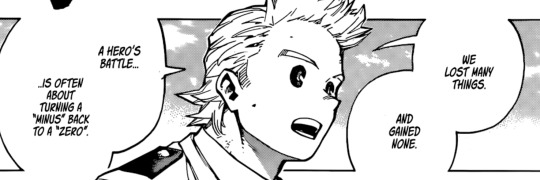
What stood out to me was Mirio's comment about how the heroes' fight "is always for the sake of returning the negatives to zero on the whole." It reminded me of Ch 341 - The Story of how We All Became Heroes Minus ① which featured Touya, Toga, Spinner and of course Tomura suffering the transformation. So I can't help but feel it's related to the LoV's fate.

The class is together 😭 crying like a proud parent (whose tumblr handle just became obsolete).... and Aizawa is staying. Yay. After 400+ chapters they made it to second year!!!

Bakugou omg, out of the hospital in a tie which he somehow tied with one hand, being calm... (it's still odd to the others? - but I guess his apology happened like 3 weeks ago in-verse). It seems like he might end up with a scar, just like Izuku (and it's a bit like Kudou's, of course).

Aoyama leaving - I talked about this in one of the asks, but for me it's ok that it's his choice being respected and that the class clearly would be happy to have him stay. Though I wonder if his parents are just suddenly given amnesty for being "AFO's victims" and what that may mean for other villains.
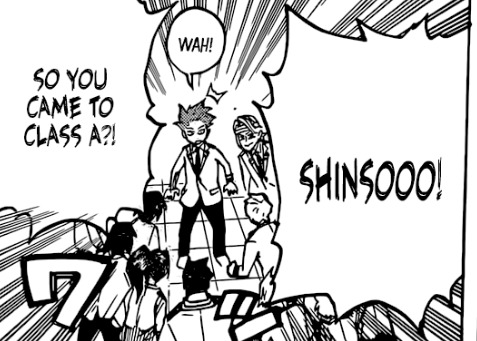
Shinsou joins Class A long at last. Yay! Is he going to get Aoyama's room or join the 5th floor boys? I do wonder if the kids are still in the dorms even.

The Fuwa-stans are getting fed. But Class 2-A (can't get used to this...) will take a year long field trip around Japan. Reminds me of the 100 million tour newpaper sketches.
I liked Shoto mentioning AFO - how he was born in an era of turmoil (which I read as him saying that preventing the rise of such villains is now). It also seems to contradict what All Might said last chapter about Deku already being the greatest hero to everyone.

But also Shouto speaks. Normal speech bubbles. Has a normal voice! Yay! (still don't get it why he didn't speak in Ch 422 though)


Izuku looks troubled. Either because of what Shouto said or because of Fuwa senpai's comments about needing to experience a sudden death to understand why you'd want to be a hero. He certainly is not ready to run celebratory circles.

Watch them all walk together (TDBK covered by Iida's speech bubble, but I recognize them from Shouto's messenger bag and Katsuki's loose pants)

OMG, these guys are a total disaster. I don't know what Deku wanted to say, but Ochako obviously shut him down (and thought it was about her "let him rest" speech which apparently the class keeps teasing her for). Also Hori is using her to explain Deku's haircut.
And here, she looks weirdly happy compared to last time, but it could be just a front...
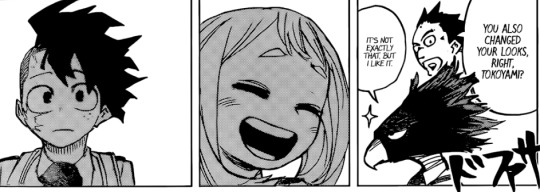
poor Deku though... he thinks she hates his haircut

No idea who the new guy is, but looks like someone escaped / let loose from a medical facility. Could be regenerated Tenko I guess or someone similar to him who can be saved by Deku this time. I prefer it to be the real Tenko because I want to see Tenko Rising. I think he looks too young to be Deku's dad tbh.
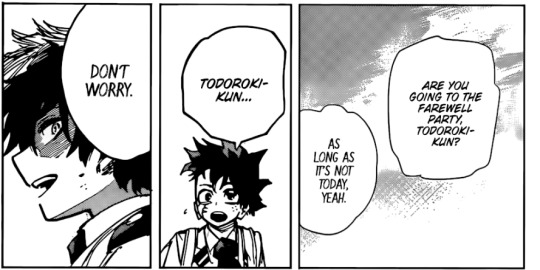
TDDK scene !!! Yay!!! (I wonder if Deku tries to talk both to Ochako and Shouto because of his feelings about Tenko... I really badly want a saviour squad scene)
Todoroki looks hopeful but not sure if it's genuine (it could be putting on a front to stop Izuku from worrying). But his foot is like when he went to see his mom the first time, so I tend to read that right now as a good sign.

"っし" (?????) - there is definitely a shift of emotion.

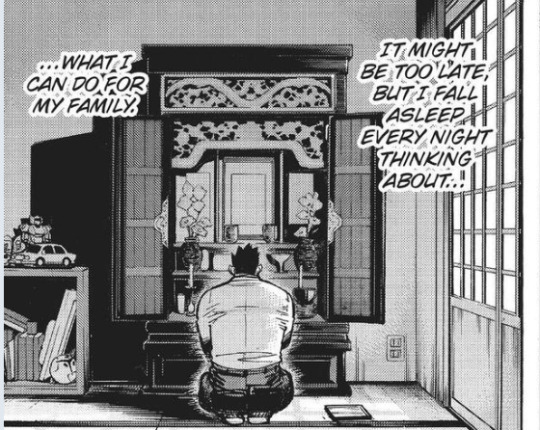
Endeavor is sitting in front of a giant tank / or secure room window. (?) (Probably the same window Shouto was looking in last chapter.
From the context and framing it's clear that it's Touya. For now alive. Endeavor is finally keeping his promise and is watching.
And the editorial blurb also suggests we may get Hellish Todoroki Family 3 after the two weeks break. I'm very worried, but also since we are strapping in for a longer epilogue it seems, I don't expect things to go smoothly for them just yet.
#bnha manga spoilers#bnha manga leaks#bnha 425#c1a reads bnha#todoroki shouto#endeavor#dabi#todoroki touya#mirio togata#bnha meta#uraraka ochako#class 2 a#that's a thing now#bakugou katsuki#mystery man
101 notes
·
View notes
Text
Personnel File: Zjardona Daro
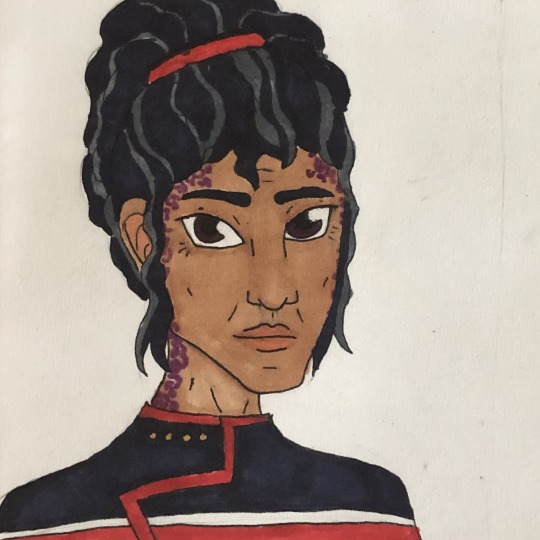
Position: Captain of the U.S.S. Tubman
Rank: Captain
Species: Trill, Joined
Gender: Female
Year of Birth: 2322
Age: 58
Place of Birth: Trill Prime
Height: 1.85 meters
Weight: 81 kilograms
Eye Color: Brown
Hair Color: Black
Family: Kanisi (Wife, Divorced 2369), Reeza Kellan (Sister, Captain of the U.S.S. Perseverance), Balel Daro (Son, Previous Host, Deceased 2367)
Education: Starfleet Academy (Class of 2347), Trill Symbiosis Commission Institute (Complete 2370)
Service Record: Ensign U.S.S. Herald (2348), Lieutenant U.S.S. Alcibiades (2351), Lieutenant Cmdr. U.S.S. Joan of Arc (2358), Commander of U.S.S. Yousafzai (2372), Captain of U.S.S Tubman (2378)
Background Story: Versatile ship and training record, primarily trained in couriering, defense, and emergency medical services, making her uniquely suited for command of an Amnesty Class Starship. Zjardona's career was primarily security oriented, but she decided to change course after the battle of Wolf 359, her son was among the casualties. In violation of Reassociation laws from which the circumstances provided pardon. The symbiont was placed in Balel's mother in order to save Daro's life. Zjardona Daro took an emergency leave of absence from Starfleet in order to train at the Symbiont Commission to assimilate the Daro symbiont, as well as to mourn the loss of her son. She was reinstated aboard the Yousafzai a decorated veteran, her first experience with an Amnesty class starship. She "fell in love with them" and currently has command of her own, one of the oldest and most venerated Amnesty Class starships, the Tubman.
Personality Profile: Highly compassionate and a consummate professional. While a more diplomatic and matronly officer now, her early Starfleet career was defined by bold decisions that harbored a militaristic edge that kept Starfleet on it's toes while she served on the Joan. That fiery disposition has not been lost but instead refined with the arrival of the Daro symbiont. She carries the tragedy of her son's death (and the similar deaths of many of Daro's previous hosts) on her shoulders with strength and grace.
Physical Profile: Average height and build for Trill female, violet tinted brown eyes, graying curly black hair, Trill markings are purple (a recessive trait amongst the species).
Special Notes: The Symbiosis Commission is a bit superstitious and overprotective regarding the Daro symbiont. Daro allegedly has a habit of inhabiting hosts who have die violently in times of war, whether they're soldiers or not. According to Starfleet records, five of Daro's seven previous hosts to Zjardona have died as civilian or military casualties, Daro barely surviving each time. This subject must be handled with diplomatic caution regarding the commission.
#star trek#star trek ocs#ocs#oc#captain Daro#captain Zjardona Daro#Zjardona daro#trill#trill symbiont#wolf 359#amnesty class#uss tubman#lar trek#oc universe#ichayalovesocs
11 notes
·
View notes
Text
what i read in dec. 2023:
(previous editions) bold = favourite
class, race, gender, & sexuality
a good prospect
damages (usa)
the moral panic against uk drill is deeply misguided
i survived a lot of edwards and now i'm team bella
death on a dairy farm (usa)
the fence (canada)
politics & current affairs
'weapons of mass migration': how states exploit the failure of migration policies
president's war against 'fake news' raises alarms in south korea
in the shadow of the holocaust
justice from below
where are they? in remembrance of victims of indonesia's enforced disappearance
culture & essays
raising the dead
one swedish zoo, seven escaped chimpanzees
the cult next door
what kind of future does de-extinction promise?
the battle over dyslexia
palestine
palestinian men are not 'terrorists in the making'
israel: starvation used as weapon of war in gaza (human rights watch)
atrocities present, past, and future
israel working to expel civilian population of gaza (un ohchr)
inhumane treatment and enforced disappearance of palestinian detainees from gaza (amnesty international)
#studyblr#studyspo#student#university#academia#dark academia#productivity#long reads#literature#myresources
178 notes
·
View notes
Text
Women warriors of China (2nd to 6th century CE)

"Warfare defined the age of disunion. Women sometimes had a role in war, and they even undertook certain forms of military service. People respected prowess in the martial arts—in women as well as men—and even empresses and noblewomen honed their skills in horseback riding and archery. For a time, it was fashionable for southern ladies to wear ornaments of gold, silver, ivory, and tortoiseshell in the shape of miniature weapons. People from earlier eras had regarded any female participation in warfare as a gross violation of the fundamental distinction between the sexes. But society had become so thoroughly militarized that it became acceptable for women to have a role in war.
During the Zhou dynasty, the military class of minor aristocrats called shi had been considered a moral elite, and strict ritual rules enforced high standards of conduct. Given the ancient connections between military service, high rank, and virtue, a female warrior could gain admiration for her moral superiority. Traditionally, women fought for the sake of Confucian virtues such as righteousness (yi) and filial piety. Han dynasty writings describe female role models noted for both bravery and virtue. Moral principles sometimes spurred women to violence, as they sought vengeance on behalf of a wronged kinsman or fended off unwanted sexual advances. Six Dynasties authors continued to celebrate virtuous female fighters. A woman who beat her husband’s murderer to death received an imperial amnesty due to her righteous behavior. And when one man wanted to force a woman to marry him, she fended him off with a sword, earning praise as a model of female integrity.
Other women took part in military operations. Emperor Wen of Jin and Empress Wenming conducted an important military campaign together, and she received equal credit for managing important military matters. Northern rulers sometimes employed women from the steppe as palace bodyguards. There was also the case of a woman who became a general, albeit under unusual circumstances. Her father, a noted military officer, had been ordered to lead an army while still in mourning for his deceased mother. He did not want to violate his mourning obligations, so he appointed one of his daughters to be general and another daughter as a high-ranking officer so that they could serve in his place. Historical records do not reveal whether these women prosecuted the war themselves or merely acted as figureheads on their father’s behalf. Either way, the soldiers consented to taking orders from a female general.
In wartime, large numbers of women found themselves pressed into military roles. During a siege, female inhabitants served alongside men on the city walls, fighting and also repairing the fortifications. And women born into military households lived a martial life. As these families tended to intermarry, their women spent their lives immersed in war. With conflict so frequent, they often accompanied their husbands on campaigns and lived in army camps. When war loomed, entire families would embark on a military campaign.
Even though classical ritual forbade women from participating in war, some nevertheless took on military roles. As the Han dynasty disintegrated, women began to have a more visible presence in military camps. Both the warlord Cao Cao and his foes used female troops on the battlefield, where they brandished spears, halberds, and bows. In that era, soldiers became a distinct social caste. The daughter of a soldier could only marry another soldier, so a woman born into a military family had no choice but to spend her life in a military environment.
The law sentenced men convicted of certain crimes, and their wives, to military service. Under the Northern Qi, both convicts and their female family members became soldiers. Like their husbands, women pressed into military service lived under strict discipline. If a man committed an infraction or absconded, authorities punished his wife as well. As in armies elsewhere in the world, most of these women lacked special skills or fighting ability. Instead they provided support, constructing fortifications, handling provisions, mending weapons, defending their camp, and doing domestic chores. Only occasionally did they go out on the battlefield.
Although the north lacked an institutionalized system of military communities, the women of military households often followed their husbands off to war. The Xianbei traditionally expected their women to be strong and to fight when necessary. The militaristic values of nomadic conquerors gave rise to the famed ballad of Hua Mulan, composed by an anonymous northern poet. In this story, when Mulan’s father is drafted, she disguises herself as a man to serve in his place. She becomes an exemplary warrior and distinguishes herself with outstanding heroism. Mulan is even offered an official post in recognition of her courage, which she modestly declines. Instead she returns home, dons female attire, and resumes conventional female life.
The tale of Mulan has captured the imaginations of generations of readers, and it continues to be retold in new ways. Although audiences today appreciate this story as an engaging fantasy, it originally seemed much closer to quotidian reality at a time when many women belonged to military households and received martial arts training. Mulan’s respect for Confucian propriety helps account for her perennial appeal. She does not dress like a man or become a warrior out of desire or ambition. Instead she sees these unpleasant actions as a way to protect her father from harm. After succeeding on the battlefield, she refuses to continue dressing as a man and bearing arms. Instead she returns home and resumes a stereotypical female life. The original readers could accept Mulan challenging gender norms and taking on a masculine identity only because she undertook it as a temporary sacrifice for the sake of moral duty. By mixing conservative Confucian integrity with startling violations of feminine decorum, Mulan has captured the hearts of numerous readers and remains an object of fascination both in China and abroad."
Women in early medieval China, Bret Hinsch
#history#women in history#women's history#women warriors#warrior women#china#chinese history#asian history#mulan#2nd century#3rd century#6th century#historyblr#historical figures#hua mulan
71 notes
·
View notes
Text
youtube
New Rule: Gender Apartheid | Real Time with Bill Maher
And finally, New Rule: if you're out protesting for a couple of hours wearing this...

... you have to go all the way and spend an afternoon running errands wearing one of these.
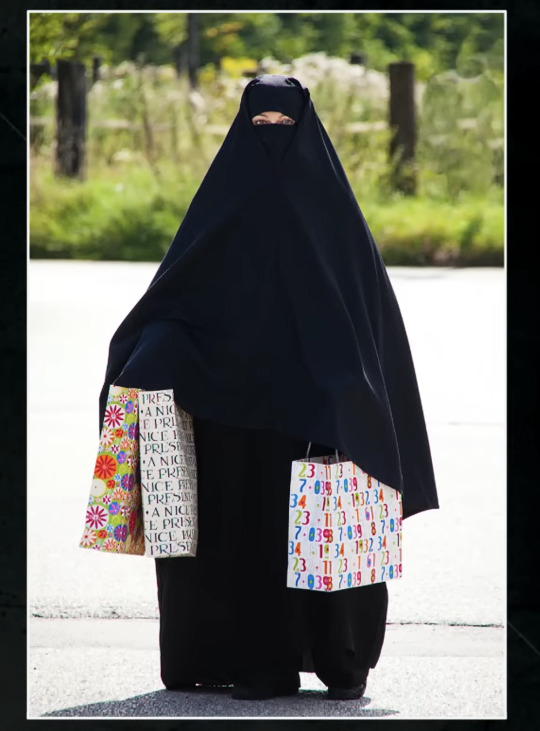
You can't side with the people who ruthlessly oppress women without at least getting a taste of what you're supporting.
Well, now that summer is here and the Hamas-backing college protesters have dispersed back to their summer internships at Goldman Sachs, I thought it might be a good time to say this: I actually admire your youthful idealism, and our world would be poorer without it. Much like your parents who just wasted 300 grand on that ignorance factory you call a college.
Not that I think it's your fault, being this poorly educated and morally confused. That takes a village. Shitty schools, overindulgent parents, social media, that priest who rubbed lotion on you.
But three cheers to you for at least having the impulse to seek a cause in something bigger than yourself. It's just that the one you picked, you missed the boat by a fucking mile.
But here's the good news. You want a cause? Cuz I totally got one for you. Apartheid. Yeah, apartheid, the thing you've been shouting about with Israel for months. Never mind that Israeli Arabs are actually full citizens. You learned that word from a 2 Chainz song and discovered that protesting South Africa's apartheid in the 80s was a righteous cause, and so it was. To this day, when celebrities are asked, who is the person they most admire, one name is always the safest choice.
So, naturally, when you heard that Israel was an apartheid state it gave you such a boner you literally pitched a tent.

You knew how wrong it was when tens of millions of South Africans had been treated like second class citizens just because of their race.
But here's the thing. Today, right now, hundreds of millions of women are treated worse than second class citizens. When you mandate that one category of human beings don't even have the right to show their face, that's apartheid. And it goes on in a lot of countries.
For the last couple years, women in Iran have been saying, "take this hijab and shove it." Because in 2022, a young woman named Mahsa Amini was arrested for wearing her mandatory hijab incorrectly and then died in police custody. And now security forces have killed over 500 people protesting her death and this obvious human rights violation. How about defunding those police?
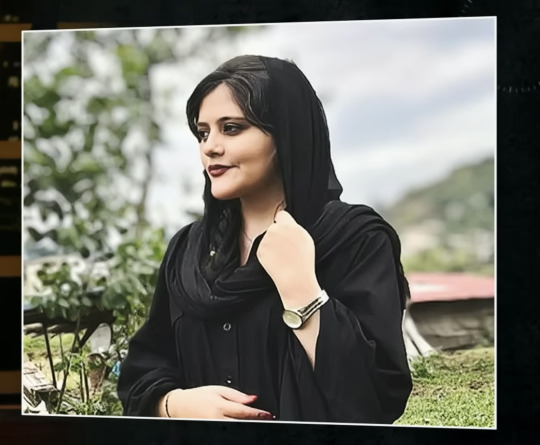

Amnesty International says that, "Iranian authorities are waging a war on women that subjects them to constant surveillance beatings sexual violence and detention." What P. Diddy calls a hotel stay.
In Iran, MeToo isn't a movement, it's what a woman says when another woman says, my life sucks.
Yasmine Muhammad is a human rights activist who got married off to a Muslim man with fundamentalist views about women not exactly uncommon in the Muslim world. He forced her to wear the niqab all the time, including once beating her because she took her hijab off at home, because the apartment had a window through which people might see in. And this was in Vancouver.
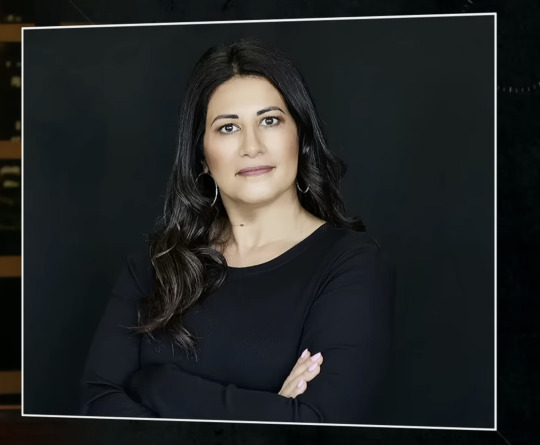
Here's what Yasmine said about veiling.
"It just suppresses your humanity entirely. It's like a portable sensory deprivation chamber and you are no longer connected to humanity. You can't see properly. You can't hear properly. You can't speak properly. People can't see you. You can only see them. Just little things. Passing people on the street and just making eye contact and smiling, that's gone. You're no longer part of this world, and so you very quickly just shrivel up into nothing under there."
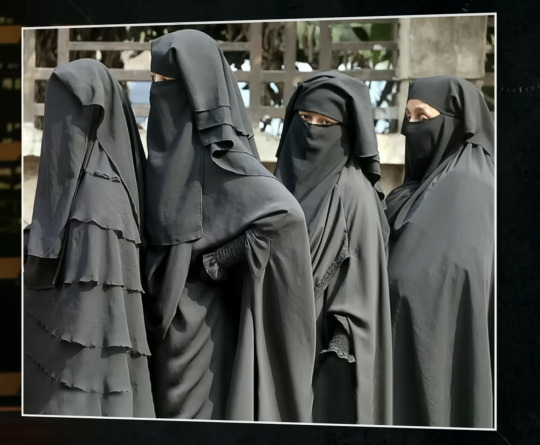


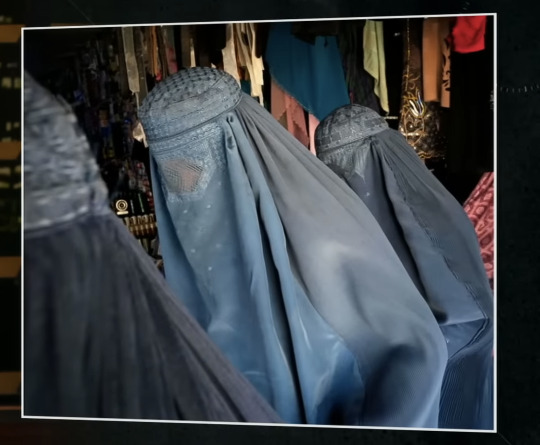



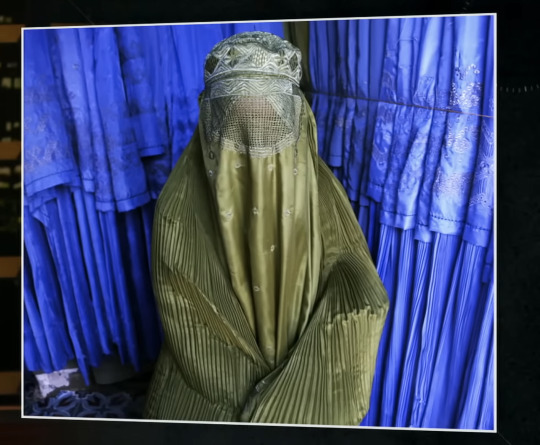
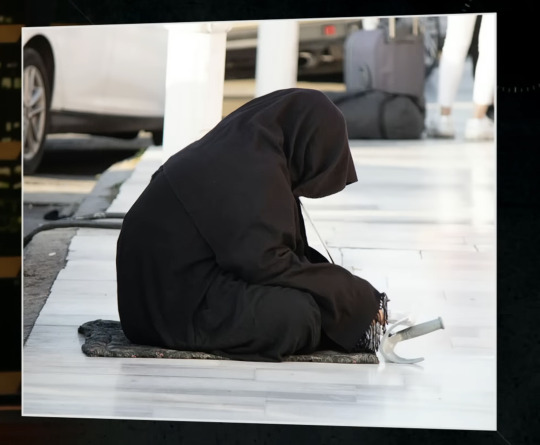
And that's my answer when someone says "Islamophobe."
Really, feminists? Come on, there's got to be a happy medium between a husband making his wife wear this, and a husband making his wife wear this.
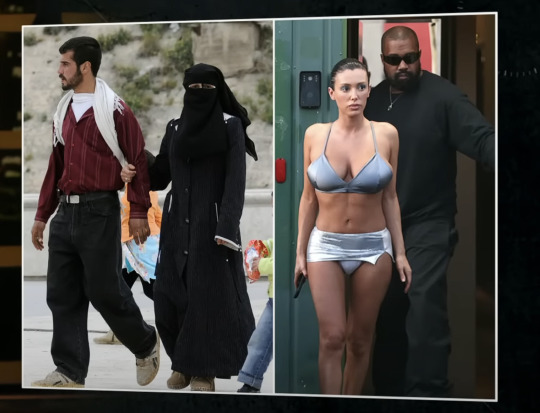
I know 1619 was bad, but this is happening right now, right under your nose rings. And it's not just the clothes. 15 countries in the Middle East, including Gaza, have laws that require women to obey their husbands. Laws. Not just Harrison Butker's opinion.
And those societies also have guardianship laws, which means a woman needs permission from her husband to work, to travel, to leave the house, to go to school, to get medical attention. Nothing?
Honor killings, where women are murdered by their own fathers and-or brothers happen so frequently they can't even have an accurate account of how many.
In 59 countries, there are no laws against sexual harassment in the workplace, and many have no laws against domestic violence or spousal rape. 20 countries have marry-your-rapist laws. Multiple societies have laws about what jobs women can and can't do. Make a Barbie movie about that. 30 countries practice female genital mutilation, and 650 million women alive today were married as children.
Kids, if you really want to change the world and not just tie up Monday morning traffic, this is the apartheid that desperately needs your attention. Gender apartheid. This is what should be the social justice issue of your time. How about, from the river to the sea, every woman shall be free?
But in reality, it's not an issue at all. For one reason: the people who are doing it aren't white. I hate to have to be the one to break it to you kids, but non-white people can do bad things too. Now, white on black racism certainly has been of one of history's most horrific scourges. But also, it's true that in today's world being non-white means you can get away with murder.
So good on you kids for following your instinct to protest social injustice. Just remember, when it comes to finding a cause, pulling your head out of your ass is an important rite of passage.
==
They won't do it not just because it's Intersectionally inconvenient, but also because it would require admitting that, as citizens of first world countries and students of Ivy League universities, not only do they not live in a "patriarchy," but they're some of the freest, most privileged, most self-determining people who have ever lived in the world at any time, ever.
And, having spent decades crafting a narrative of being long-suffering and "oppressed," they'd have to surrender the significant social, political and economic capital that narrative affords, by fighting for women in Iran, Gaza, Afghanistan and other countries to have the same rights and privileges they take for granted. And regularly spit on.
#Bill Maher#Real Time with Bill Maher#pro palestine#college protests#student protests#feminism#western feminism#islam#hijab#Yasmine Mohammed#Iran#islamic regime#Mahsa Amini#iran protests#gender apartheid#apartheid#islam ruins everything#gaza strip#anti apartheid#this is islam#religion#religion is a mental illness#Youtube
59 notes
·
View notes
Text
for years palestinians told the world what was happening to them. and un report after un report amnesty report after amnesty report and no one listened and they did their class room debates and media debates and went home to their normal lives and the occupation lived on, the siege lived on.
154 notes
·
View notes
Text
youtube
About half a year later I’m remembering to post amnesty opening! I made it as an final for one of my classes but definitely took it way beyond the requirements because I was having fun lmao
#enjoy taz fans :)#redribbonmagpie art#my art#taz#taz amnesty#taz a#taz: amnesty#the adventure zone#the adventure zone amnesty#duck newton#aubrey little#ned chicane#animated opening#animated theme song#horror#paranormal#podcast fanart#Youtube
136 notes
·
View notes
Note
Hi, I want to ask if you have any topics about the Philippine-American War? I have gotten myself in Philippine History and I want to know deeper. Thanks:)
I was thinking of many ways on how to answer this because this is such a large and complicated topic but I could just try to summarize some stuff here and tell you what I know and what I could find.
The Filipino-American war mainly started as Filipinos felt betrayed by their former American allies after the country was sold to them by Spain after the Spanish-American war during the Treaty of Paris of 1898 for $20 million alongside other Spanish colonies like Puerto Rico, Guam, and Cuba (American Historical Association, n.d.). This feeling of betrayal had come from the fact that the leader and dictator president of the Filipino revolutionaries, Emilio Aguinaldo of the Kataastaasang Kagalang-galang Katipunan ng mga Anak ng Bayan (en. The Supreme and Honorable Association of the Children of the Nation) or the Katipunan for short, actually sought assistance from the Americans in Hong Kong during the Filipino Revolutionary War against Spain which was happening at the same time (Kedmey, 2013). This is why tensions were so high with the Americans when they first formally colonized the Philippines.
Interestingly, the purchase also included some territories that weren't actually part of Spanish rule such as the Sultanate of Sulu as well as some indigenous territories which led to a strained relationship with the Americans moving forward such as the independent Moros of Muslim Mindanao later being forced to assimilate to the rest of the colony of the Philippines despite previous agreements that state that they will leave them alone, mirroring the way the United States government treated Native Americans (Gowing, 1968).
Fighting between the American army and the Filipino army first broke out when on February 4, 1899 after Private William W. Grayson fired at 4 Filipino soldiers who cocked their rifles in response to them ordering the men to halt which later broke out into the Battle of Manile of 1899 (Chaput, 2012). As the Filipinos and Americans declared war on each other, the Katipuneros resorted to the mountains to start guerilla warfare against the American army (Philippine-American War, n.d.) which then lasted until 1901 when Aguinaldo was captured on March 23, 1901, just a day after Aguinaldo's birthday actually with the capture being attributed to two of his men, Lazaro Segovia and Hilario Tal Placido who betrayed him to the Americans with his other men still being too relaxed from the festivities the day before (Ocampo, 2010).
The fighting continued despite his capture and surrender until the last of the generals, General Macario Sakay, surrendered in July 14, 1906 who was then later executed along side his men on September 13, 1907 despite the initial promise of amnesty by the American government (Pangilinan & Pimintel, 2008).
The war ended the lives of 4,300 American soldiers with only 1,500 having been killed in action with the rest succumbing to diseases, while Filipino forces suffered 20,000 casualties alongside the death of 200,000 Filipino civilians due to hunger, disease, and combat (Philippine-American War, n.d.).
The violence of the situation and especially committed by the American soldiers prompted a lot of protests in the United States to stop the war immediately, as letters of the situation had been sent back to their homes which describes in excruciating detail the war crimes that these soldiers were ordered to commit such as blockading and burning down villages, extreme torture of captured and suspected enemies, and much more. The most well-known of these torture methods that I remember being taught to us in history classes as early as 4th grade was the "Water Cure" where American soldiers would force water down the victim's throat in and force them to vomit it back out. This article has a detailed account of the exact nature of this torture method as it discusses the torture of Mayor Joveniano Ealdama of Igbaras, who, although no American troop was actually hurt in his town, was tortured with his town being burnt down by the Americans the very next day (Vestal, 2017).
I do have to be honest, I was utterly shocked at how little Americans really knew about the Philippine American colonial era and by extension the Philippine-American war especially with the sheer amount of brutality the Americans had done to Filipino locals as well as the large impact the American government and American culture has had in my country and I am glad that more and more people are starting to learn more about this but it's still rather disappointing.
Videos on the Philippine-American War
If you want to learn more about the Philippine-American War, I have a couple of recommendations for videos that you can watch.
This video by Crash Course explains the origins of American Imperial idealization as well as the wars that led up to the colonization of the many territories that America acquired during this time era:
youtube
Here's a good summary by history teacher Mr. Beat of the major aspects of the war as well as the American public's perception of it that you can watch:
youtube
Here's a video made with a Filipino-perspective by Jonas Tayaban on the topic:
youtube
Here's a summary in Tagalog. It doesn't have English subtitles though but it does detail more things about the build-up and the subsequent wars between Spain and America and later the Philippines and Spain and then America too:
youtube
Movies about the Philippine-American War
I would also be remiss to not suggest some historical movies that tackle the events of this time period and especially TBA Studios' Artikulo Uno films Heneral Luna (2015) which focuses on the most popular and effective general of the revolution Gen. Antonio Luna, and Goyo: Ang Batang Heneral (2018) which focuses on Gregorio "Goyo" del Pilar, one the youngest generals of Filipino history who died a very tragic death at a young age:
youtube
You can watch the full movie here complete with English Subtitles
youtube
Another well-known movie about this time period is Viva Films' El Presidente (2012), although I had heard people say it's very much biased to the controversial dictator president Aguinaldo's side with many people citing that as the reason why they don't like the film.
youtube
Here's a reupload of the full-movie. It doesn't have subtitles though.
I don't know of any American-made movies that focuses on this topic and I know there's several other films that focus more on the politics of the Katipunan and the Filipino Revolutionary War against Spain, but not necessarily the Philippine-American War so if anyone has other suggestions, please let me know.
I would also like to suggest documentaries but most of the ones I've seen are on World War II and the others are other YouTube videos by history channels that I'm not too familiar with made by mostly white American YouTubers. Not that that would disqualify their videos (I did reference both John Green and Mr. Beat here) but I don't know these history channels and their hosts enough to recommend them in good faith as of right now.
Books and Further Reading on the Philippine-American War
For books on the subject, I often reference the many writings of Ambeth Ocampo such as his Looking Back series, specifically:
Looking Back 2: Dirty Dancing (Shopee, Lazada, Amazon)
Looking Back 11: Independence x6 (Shopee, Lazada)
Looking Back 13: Guns of the Katipunan (Shopee, Lazada)
I'm also currently interested in buying some other books about the topic like The Hills of Sampaloc: The Opening Actions of the Philippine-American War, February 4-5, 1899 (Shopee, Amazon) but I don't really have any extra money to spare for it right now.
I remember that my father had some other books about this too but the names had escaped me and it's far too much work to try to sort out through his entire book pile in our house.
I hope this answer's comprehensive enough since the subject is, as I said before, quite complex and rather large so I can't really get into all the specifics right now.
References:
American Historical Association. (n.d.). How Did America Enter the Picture?. Retrieved on 3 February 2024, from https://www.historians.org/about-aha-and-membership/aha-history-and-archives/gi-roundtable-series/pamphlets/em-24-what-lies-ahead-for-the-philippines-(1945)/how-did-america-enter-the-picture
Chaput, D. (2012). Private William W Grayson's War in the Philippines, 1899. Retrieved on 3 February 2024, from https://ne-test-site8.cdc.nicusa.com/sites/ne-test-site8.cdc.nicusa.com/files/doc/publications/NH1980GraysonWar1899.pdf
Gowing, P. (1968). Muslim-American Relations in the Philippines, 1899-1929. Retrieved on 3 February 2024, from https://asj.upd.edu.ph/mediabox/archive/ASJ-06-03-1968/gowing-muslim-american%20relations%20in%20the%20philippines%201899-1920.pdf
Kedmey, D. (2013, June 13). Exiled in Hong Kong: Famous Company for Edward Snowden.Time. Retrieved on 3 February 2024, from https://world.time.com/2013/06/15/exiled-in-hong-kong-famous-company-for-edward-snowden/slide/general-emilio-aguinaldo/
Ocampo, A. (2010). Looking Back 2: Dirty Dancing. Anvil Publishing
Pangilinan, F., & Pimintel, A. (2008, September 9). A Resolution Expressing the Sense of the Senate Honoring the Sacrifice of Macario Sakay and all other Filipinos who Gave Up their Lives in the Philippine-American War for our Freedom, Senate Resolution No. 623, 14th Congress of the Republic of the Philippines. Retrieved on 3 February 2024, from http://legacy.senate.gov.ph/lisdata/83927584!.pdf
Philippine-American War. In Britannica. Retrieved on 3 February 2024, from https://www.britannica.com/event/Philippine-American-War
Vestal, A. (2017). The First Wartime Water Torture by Americans. Retrieved on 3 February 2024, from https://digitalcommons.mainelaw.maine.edu/mlr/vol69/iss1/2/
#filipinfodump#filipino history#american history#history#filipino-american history#philippine-american war#military history#colonial history#imperialism#american imperialism#american colonization#american colonial era#philippines#america#filipino#katipunan#us military#president emilio aguinaldo#general antonio luna#general gregorio del pilar#filipino heroes#filipino presidents#john green#crash course history#crash course american history#mr. beat#jonas tayaban#moobly tv#filipino movies#heneral luna (2015)
80 notes
·
View notes